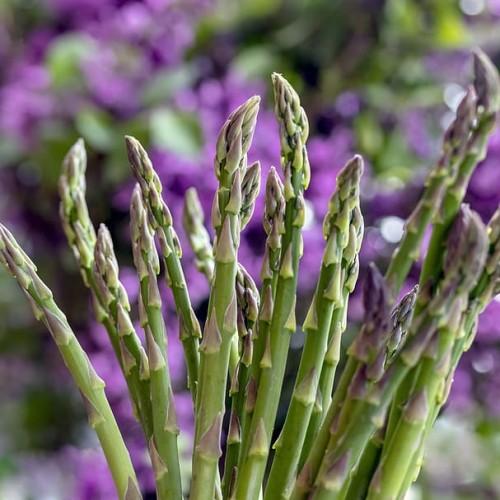
asparagus
Asparagus officinalis 'Jersey Knight'
Cycle:
Herbaceous Perennial
Watering:
Average
Hardiness Zone:
3 - 10
Flowers:
Flowers
Sun:
Full sun
Leaf:
Yes
Growth Rate:
High
Maintenance:
Low
Salt Tolerant:
Yes
Care Level:
Medium
watering
Asparagus (Asparagus officinalis 'Jersey Knight') should be watered deeply once a week during spring and summer months when temperatures are warmer. In the cooler months of autumn and winter, once every 2 weeks should be sufficient. The soil should be kept evenly moist but not soggy, as over-watering can cause root rot. It is important to avoid wetting the stems and foliage when watering. It is best to use a soaker hose or drip irrigation system to slowly seep water in the ground directly to the plants' root zone.
sunlight
Asparagus officinalis 'Jersey Knight' does best when planted in a location with plenty of full sun. This plant prefers at least 6 to 8 hours of direct sunlight each day, ideally in the morning with some afternoon shade. For optimal growth, providing some afternoon shade can be beneficial. This plant also prefers well-drained, slightly acidic soil. It can tolerate drought, but will thrive in moist, fertile soils.
pruning
Asparagus officinalis 'Jersey Knight' should be pruned once a year after the harvest season. Pruning should be done lightly to remove any dead foliage, and also to prevent any overcrowding. When pruning, only remove about a third of the spears from the base of the plant. After the spears have been harvested, use a pair of sharp pruners to remove any spears growing more than 4 inches away from the main plant. This will help to promote air flow throughout the plant, enabling it to receive more sunlight, moisture, and nutrients. Pruning can also help to prevent diseases and pests from taking hold in the plant.
Propagation
Season
Hardiness Map
FAQ
Is asparagus classified lilies or onions?
No, asparagus is not classified as either lilies or onions. Asparagus is a vegetable that is a member of the lily family, but it is not a lily itself nor is it an onion. Asparagus is a flowering plant and its edible part is the young shoots. It is high in dietary fiber and is a good source of vitamin A, vitamin C, vitamin E, vitamin K, and other vitamins and minerals.
Do asparagus plants not to be overwatered?
Yes, asparagus plants should not be overwatered. When planted outdoors, they should only receive enough water to keep the soil moist, but not soggy. If planted indoors, they should be watered when the soil is dry to the touch and the water should not be left to pool in the container or saucer. Overwatering asparagus plants can cause root rot and fungal diseases that can damage the plants.
Can I cultivate asparagus plant in a xeriscaping garden?
Yes, you can cultivate asparagus plant in a xeriscaping garden. Asparagus is a hardy, drought-tolerant plant that can survive well in low-water gardens. To successfully grow asparagus in a xeriscaping garden, the soil should be nutritiously rich with a slightly acidic pH. Choose a spot that gets full sun and provide your asparagus bed with a generous amount of mulch to retain moisture. Asparagus requires a deep, moderately moist soil—deep enough for the roots to grow. Provide your bed with regular watering, but do not over-water. Asparagus produces edible spears in its second season so if you plan to grow asparagus in your xeriscaping garden, be prepared to be patient.
Can asparagus be growing as a cover crop?
Yes, asparagus can be grown as a cover crop. As a cover crop, asparagus is non-invasive and nitrogen-fixing. It can be planted in cool climates starting in late winter and provides a living mulch with dense foliage that can be harvested throughout the season. It also helps protect the soil and provide erosion control, and it can be mowed or tilled in at the end of the season to return nutrients to the soil. Asparagus can even be intercropped with other vegetables, helping to increase yields and prevent disease.
Should I remove any wild asparagus plants from my garden?
Removing wild asparagus plants from your garden is entirely up to your personal preference. If you want more control over how many plants you have and what plants you have, then you may want to remove any wild asparagus plants. Wild asparagus plants can spread quickly and become difficult to control and manage. If you are okay with that then you may want to leave them in your garden. However, make sure you don't inadvertently dig up the wild asparagus plants and harm them. If you do decide to remove them make sure to do it responsibly so not to obsessively disturb the surrounding environment.
Are there any health benefits of asparagus roots?
Yes, there are numerous health benefits to eating asparagus roots. It is an excellent source of vitamins A, C, K, and B6, as well as minerals like copper, selenium, and iron. It also contains many antioxidants and is a good source of dietary fiber. Asparagus root also contains essential amino acids like lysine, leucine, and tryptophan, which are important for cellular health and energy production. Additionally, Asparagus root may provide potential anti-inflammatory and anti-cancer benefits.
